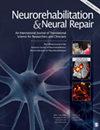双侧小脑间歇θ波爆发刺激联合吞咽言语治疗卒中后吞咽困难:一项随机、双盲、假对照的临床试验
IF 3.7
2区 医学
Q1 CLINICAL NEUROLOGY
引用次数: 8
摘要
背景:既往研究发现,小脑半球高频重复经颅磁刺激(rTMS)可改善吞咽功能,但具有类似兴奋作用且效率更高的间歇性θ波爆发刺激(iTBS)是否也能改善脑卒中后吞咽困难患者的吞咽功能尚不清楚。目的:探讨双侧小脑经颅磁刺激联合iTBS治疗脑卒中后吞咽困难的疗效和安全性。方法:将70例脑卒中后吞咽困难患者分为真双侧小脑iTBS和假双侧小脑iTBS两组。真正的iTBS组进行10次100%静息运动阈值(RMT) iTBS,持续2周。在假iTBS组中,除了数字8线圈垂直于颅骨外,其他参数相同。两组均给予传统吞咽康复治疗,每周5次,连续2周。在基线、干预后2周和随访4周时,采用光纤内镜吞咽困难严重程度量表(FEDSS)、渗透/吸入量表(PAS)、标准化吞咽评估量表(SSA)和功能性口服摄入量表(FOIS)评估吞咽功能。结果:多因素调整和未调整的FEDSS、PAS、SSA和FOIS评分均存在显著的时间和组间交互效应(P < 0.001)。两组吞咽参数两两比较,2周和4周时,iTBS模拟组的FEDSS、PAS、SSA、FOIS评分改善明显高于假手术组(P < 0.05)。在真iTBS和假iTBS刺激组中,所有FEDSS、PAS、SSA和FOIS评分均随时间显著提高(P < 0.001)。结论:iTBS是一种更有效的经颅磁刺激方式,可通过刺激双侧小脑半球有效改善吞咽功能。此外,100%静息运动阈值双侧小脑iTBS是一种相对安全的治疗方法。临床试验注册:反复经颅磁刺激小脑治疗脑卒中后吞咽困难的效果分析。www.chictr.org.cn。标识符:ChiCTR2100042092。本文章由计算机程序翻译,如有差异,请以英文原文为准。
Bilateral Cerebellar Intermittent Theta Burst Stimulation Combined With Swallowing Speech Therapy for Dysphagia After Stroke: A Randomized, Double-Blind, Sham-Controlled, Clinical Trial
Background: Previous studies have found that high-frequency repetitive transcranial magnetic stimulation (rTMS) of the cerebellar hemisphere could improve swallowing function, but whether intermittent theta burst stimulation (iTBS), which has similar excitatory effect and higher efficiency, can also improve swallowing function for dysphagia after stroke remains unclear. Objective: This trial aimed to explore the efficacy and safety of bilateral cerebellar transcranial magnetic stimulation with iTBS for dysphagia after stroke. Methods: Seventy patients with dysphagia after stroke were divided into 2 treatment groups: true bilateral cerebellar iTBS and sham bilateral cerebellar iTBS. The true iTBS group underwent ten 100% resting motor threshold (RMT) iTBS sessions for 2 weeks. In the sham iTBS group, the parameters were the same except that the figure-eight coil was perpendicular to the skull. Both groups received traditional swallowing rehabilitation treatment 5 times a week for 2 weeks. Swallowing function was assessed with the Fiberoptic Endoscopic Dysphagia Severity Scale (FEDSS), Penetration/Aspiration Scale (PAS), Standardized Swallowing Assessment (SSA), and Functional Oral Intake Scale (FOIS) at baseline, 2 weeks after the intervention, and at 4 weeks of follow-up. Results: There were significant time and group interaction effects in both multi-factorial adjusted and unadjusted FEDSS, PAS, SSA, and FOIS score (P < .001). In the pairwise comparison of the swallowing parameters among the 2 groups, the FEDSS, PAS, SSA, and FOIS scores at 2 weeks and 4 weeks showed a significantly higher improvement in the iTBS simulation group than sham group (P < .05). In both the true iTBS and sham iTBS stimulation groups, all FEDSS, PAS, SSA, and FOIS scores were significantly improved over time (P < .001). Conclusions: The present study suggested that as a more efficient TMS stimulation mode, iTBS could efficiently improve swallowing function by stimulating the bilateral cerebellar hemisphere. In addition, 100% resting motor threshold bilateral cerebellar iTBS is a relatively safe treatment. Clinical Trial Registration: Effect analysis of repeated transcranial magnetic stimulation of cerebellar on dysphagia after stroke. www.chictr.org.cn. Identifier: ChiCTR2100042092.
求助全文
通过发布文献求助,成功后即可免费获取论文全文。
去求助
来源期刊
CiteScore
8.30
自引率
4.80%
发文量
52
审稿时长
6-12 weeks
期刊介绍:
Neurorehabilitation & Neural Repair (NNR) offers innovative and reliable reports relevant to functional recovery from neural injury and long term neurologic care. The journal''s unique focus is evidence-based basic and clinical practice and research. NNR deals with the management and fundamental mechanisms of functional recovery from conditions such as stroke, multiple sclerosis, Alzheimer''s disease, brain and spinal cord injuries, and peripheral nerve injuries.

 求助内容:
求助内容: 应助结果提醒方式:
应助结果提醒方式:


